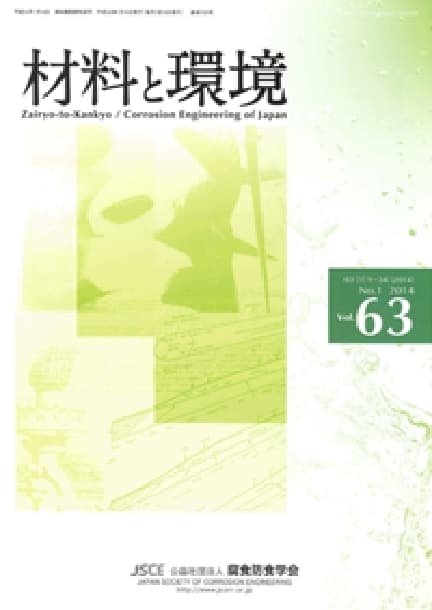- TOP
- Zairyo-to-Kankyo
- Vol. 57 (2008), No. 9
Zairyo-to-Kankyo Vol. 57 (2008), No. 9
Backnumber
-
Vol. 74 (2025)
-
Vol. 73 (2024)
-
Vol. 72 (2023)
-
Vol. 71 (2022)
-
Vol. 70 (2021)
-
Vol. 69 (2020)
-
Vol. 68 (2019)
-
Vol. 67 (2018)
-
Vol. 66 (2017)
-
Vol. 65 (2016)
-
Vol. 64 (2015)
-
Vol. 63 (2014)
-
Vol. 62 (2013)
-
Vol. 61 (2012)
-
Vol. 60 (2011)
-
Vol. 59 (2010)
-
Vol. 58 (2009)
-
Vol. 57 (2008)
-
Vol. 56 (2007)
-
Vol. 55 (2006)
-
Vol. 54 (2005)
-
Vol. 53 (2004)
-
Vol. 52 (2003)
-
Vol. 51 (2002)
-
Vol. 50 (2001)
-
Vol. 49 (2000)
-
Vol. 48 (1999)
-
Vol. 47 (1998)
-
Vol. 46 (1997)
-
Vol. 45 (1996)
-
Vol. 44 (1995)
-
Vol. 43 (1994)
-
Vol. 42 (1993)
-
Vol. 41 (1992)
-
Vol. 40 (1991)
Keyword Ranking
14 Dec. (Last 30 Days)
Zairyo-to-Kankyo Vol. 57 (2008), No. 9
Passive Films on Stainless Steels −Present State of Analysis and Understanding
Katsuhisa Sugimoto
pp. 375-384
DOI:
10.3323/jcorr.57.375Abstract
Recent experimental results on the thickness, composition, conduction type, bandgap and impedance diagram of passive films on stainless steels were reviewed first. The change in conditions of passive films was shown as a function of potential. Then, the electrochemical nature of artificial passivation films that simulated the thickness and composition of passive films was introduced. The protective ability of passive films against chloride pitting was discussed in accordance with the electrochemical nature of artificial passivation films. Finally, some future subjects were proposed for the better understanding of passive films.
Influence of Anions on Corrosion Behavior of Zinc in Tap Water
Yasuki Matsukawa, Mamoru Miyashita, Shukuji Asakura
pp. 392-399
DOI:
10.3323/jcorr.57.392Abstract
This study was conducted in order to clarify the corrosion behavior of galvanized steel pipes which have often been used for building facilities such cooling water systems. We observed corrosion rates, corrosion potentials, and corrosion products of zinc in tap water of Tsukuba city, distilled water and solutions of some salts at 40°C.
The effects of anions on the corrosion of zinc are summarized as follows. HCO3− inhibits the corrosive reaction. The inhibitive nature of HCO3− comes from the formation of Zn4CO3(OH)6·H2O which retards the anodic reaction. On the other hand, SO42−, Cl−, and NO3− promote the corrosion. The order of promotion is determined experimentally as SO42−>Cl−>NO3− in the concentration of various anion range (<1 mmol L−1) included in tap water. SO42− and Cl− promote the corrosion reaction by destructing the protective ability of surface films. NO3− activates the cathodic reaction, due to its oxidizing nature.
Distilled water was more corrosive than tap water of Tsukuba city. This is due to the salts in tap water, which form the protective films on zinc. The corrosivity of tap water could be discussed on the basis of present paper.
Morphological Change of Fibroblast Cells on Titanium and Platinum Cultured at Anodic and Cathodic Potentials
Sachiko Hiromoto, Joerg Ziegler, Akiko Yamamoto
pp. 400-408
DOI:
10.3323/jcorr.57.400Abstract
To understand cellular response against applied potential on different electrode materials, cell morphology and cell coverage of murine fibroblast L929 cultured on Ti and Pt electrodes were examined. Anodic and cathodic potentials were applied on Ti and Pt using a potentiostat. At the anodic potentials of 800 and 950 mV vs. Ag/AgCl, no cells kept a normal shape on both Ti and Pt. At the cathodic potential of −350 mV, the cells on Ti were normally extended ; whereas some of the cells on Pt were aggregated or round. At −1000 mV, the cells had spherical shape on Ti, while the Pt surface was covered by white precipitates with no cell remained. The change in cell morphology and the decrease in coverage at anodic potentials were significantly larger than those at the cathodic potentials. The morphological change of L929 on Ti was rather smaller than that on Pt at the same potentials, which is probably because the electric filed around the cells on Ti is smaller than that on Pt owing to the surface oxide film on Ti. These facts indicate that the cell response to the applied potential depends on the azimuth of electric field and electrode materials.
Article Access Ranking
14 Dec. (Last 30 Days)
-
Delayed Fracture Mechanism of 1700 MPa-Class Quenched and Tempered Bolt under Atmospheric Corrosion Environment
Tetsu-to-Hagané Advance Publication
-
Perspectives on the Promising Pathways to Zero Carbon Emissions in the Steel Industry toward 2050
ISIJ International Vol.65(2025), No.2
-
Effect of B on Surface Oxidation Behavior and Phosphatability of Si-Mn-added Cold-Rolled Steel Sheets
ISIJ International Advance Publication
-
Factors Influencing the Bonding Phase Structure of Iron Ore Sinters
ISIJ International Vol.43(2003), No.9
-
Effect of microstructural heterogeneity on fatigue limit of as-quenched low-carbon low-alloy martensitic steel
ISIJ International Advance Publication
-
Prussian blue as a fully reversible hydrogenochromic material for visualizing hydrogen distribution in Fe sheet
ISIJ International Advance Publication
-
Progress of Strip Casting Technology for Steel; Historical Developments
ISIJ International Vol.52(2012), No.12
-
Research Progress on Optimal Blending of Iron Ore Powders for Sintering
ISIJ International Vol.65(2025), No.12
-
-
Microstructures and Reduction Properties of High CaO Concentration Sintered Ore
ISIJ International Advance Publication
You can use this feature after you logged into the site.
Please click the button below.










